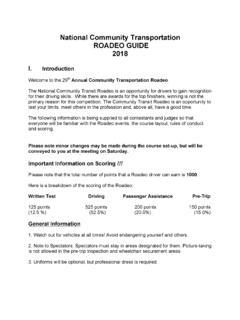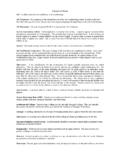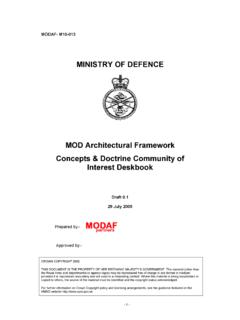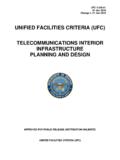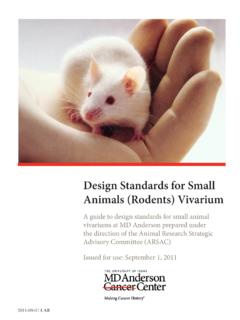Transcription of Glossary of Transportation Terms - web1.ctaa.org
1 Glossary of Transportation Terms Access Board: Common name for the architectural and Transportation Barriers Compliance Board, an independent Federal agency whose mission is to develop guidelines for accessible facilities and services and to provide technical assistance to help public and private entities understand and comply with the Americans with Disabilities Act (ADA). Accessibility: The extent to which facilities, including transit vehicles, are free of barriers and can be used by people who have disabilities, including wheelchair users. ADA complementary paratransit service: The Americans with Disabilities Act (ADA). requires public transit agencies that provide fixed-route service to provide complementary paratransit services to people with disabilities who cannot use the fixed-route bus or rail service because of a disability. The ADA regulations specifically define a population of customers who are entitled to this service as a civil right.
2 The regulations also define minimum service characteristics that must be met for this service to be considered equivalent to the fixed-route service it is intended to complement. In general, ADA. complementary paratransit service must be provided within 3/4 of a mile of a bus route or rail station, at the same hours and days, for no more than twice the regular fixed route fare. Administration on Aging (AoA): An agency of the Department of Health and Human Services. It is headed by an Assistant Secretary for Aging. It is the federal focal point and advocacy agency for older persons, as mandated by OAA, and administers most OAA. programs at the federal level. AoA funds six core services: supportive services (among which is Transportation ); nutrition; preventive health services; National Family Caregiver Support Program; services that protect the rights of vulnerable older persons; and service to Native Americans.
3 AoA provides leadership, technical assistance, and support to the national aging network. (See National Aging Network). Alternative fuels: Vehicle engine fuels other than standard gasoline or diesel. Typically, alternative fuels burn cleaner than gasoline or diesel and produce reduced emissions. Common alternative fuels include methanol, ethanol, compressed natural gas, liquefied natural gas, clean diesel fuels and reformulated gasoline. American Public Transit Association (APTA): APTA is a nonprofit international association of nearly 1,500 member organizations including public Transportation systems;. planning, design, construction and finance firms; product and service providers; academic institutions; and state associations and departments of Transportation . APTA members serve the public interest by providing safe, efficient and economical public Transportation services and products.
4 APTA members serve more than 90 percent of persons using public Transportation in the United States and Canada. Americans with Disabilities Act (ADA): Passed by Congress in 1990, this Act mandates equal opportunities for people with disabilities in the areas of employment, Transportation , communications and public accommodations. Under this Act, most Transportation providers are obliged to purchase lift-equipped vehicles for their fixed-route services and must ensure system-wide accessibility of their demand-responsive services to people with disabilities. Public transit providers also must supplement their fixed-route services with paratransit services for those people unable to use fixed-route service because of their disability. Area Agency on Aging (AAA or Triple A): A public or private non-profit agency, designated by the state to address the needs and concerns of all older Americans at the regional and local levels.
5 The term "area agency on aging" is a generic term specific names of local AAAs [IRS designation of 501(c)(3)].may vary. Triple As are primarily responsible for a geographic area that is a city, a single county or a multi-county district. Triple As may be characterized as: county, city, regional planning council, council of governments, or private, non-profit. All Triple As perform three important functions: Creating multi-year plans; providing information and referral on available services and programs; and Coordinating OAA and other funds that support their service area. Bond: A three-party agreement providing legal assurance of contract. A transit provider may request/require prospective contractors to provide a bid bond a guarantee that the bidding party will fulfill the Terms of the bid, and, if not, that a third party (usually an insurance company) will pay any cost difference bond that ensures restitution should the winning contractor fail to perform in accordance with specific contract Terms .
6 Brokerage: A method of providing Transportation where riders are matched with appropriate Transportation providers through a central trip-request and administrative facility. The Transportation broker may centralize vehicle dispatch, record keeping, vehicle maintenance and other functions under contractual arrangements with agencies, municipalities and other organizations. Actual trips are provided by a number of different vendors. Bus testing: Originally drafted in 1989, the Federal Transit Administration (FTA) Bus Testing regulations mandate that all transit vehicle models purchased with FTA money must undergo testing at FTA's Altoona, PA bus testing site. Busway: A roadway reserved for buses only. Also known as a bus lane.. Buy America: Federal Transportation law which requires that all purchases of vehicles, equipment or any other manufactured item be of and assembled components, unless the purchase price is less than $100,000 or the Department of Transportation has given the purchaser a Buy America waiver.
7 Capital costs: Refers to the costs of long-term assets of a public transit system such as property, buildings and vehicles. Can include bus overhauls, preventive maintenance, mobility management, and even a share of transit providers' ADA paratransit expenses. Circulars: Program management guidelines issued by federal agencies. The Federal Transit Administration (FTA) publishes and updates its circulars to communicate funding program requirements. In May 2007, the FTA published circulars concerning the FTA's Section 5310, 5316, and 5317 programs. Circulator bus: A bus that makes frequent trips around a small geographic area with numerous stops along the route. It is typically operated in a downtown area or an area that attracts tourists or large crowds and has limited parking and congested roads. It may be operated all day or only at times of peak demand, such as rush hour or lunch time.
8 Clean Air Act: Federal legislation that details acceptable levels of airborne pollution and spells out the role of state and local governments in maintaining clean air. Commercial Driver's License (CDL): The standardized driver's license required of bus and heavy truck drivers in every state. Covers drivers of any vehicle manufactured to seat 15 or more passengers (plus driver) or over 13 tons gross vehicle weight. The CDL is mandated by the Federal government in the Commercial Motor Vehicle Safety Act of 1986. Community Transportation : The family of Transportation services in a community, including public and private sources, that are available to respond to the mobility needs of all community members. Community Transportation Association of America (CTAA): A national professional association of community Transportation providers and supporters, including operators, vendors, consultants, and federal, state and local officials.
9 Congestion Mitigation and Air Quality Project (CMAQ): A flexible funding program administered by the Federal Highway Administration that funds projects and programs to reduce harmful vehicle emissions and improve traffic conditions. CMAQ funds may be used for transit projects, rideshare projects, high-occupancy vehicle lanes or other similar purposes. Council of Governments (COG): A voluntary association of local governments that operates as a planning body. COGs collect and disseminate information, review applications for funding, and provide services common to its member agencies. Coordinated Public Transit Human Services Transportation Plan: A locally developed plan for coordinating local public Transportation and human service agency Transportation services that aims to maximize the programs' collective coverage by minimizing duplication of services. The coordinated plan should be developed through a process that includes representatives of public, private and non-profit Transportation and human services providers, and participation by the public.
10 Under SAFETEA-LU, any public agency applying for funding of a new or expanded service under Sections 5310, 5316, or 5317 must show that the be derived from a locally developed, coordinated public transit-human services Transportation plan developed through a process that consists of representatives of public, private, and non-profit Transportation and human services providers with participation by the public. Coordination: A cooperative arrangement among public and private Transportation agencies and human service organizations that provide Transportation services. Coordination models can range in scope from shared use of facilities, training or maintenance to integrated brokerages or consolidated Transportation service providers. Curb-to-curb service: A common designation for paratransit services. The transit vehicle picks up and discharges passengers at the curb or driveway in front of their home or destination.

